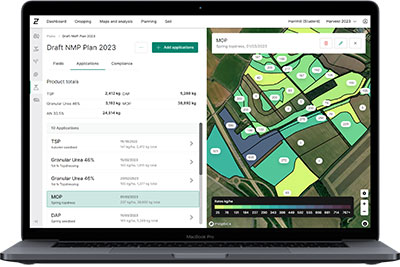Our environmental advisors are encouraging farmers to follow voluntary guidance where possible, to ensure the aims of the scheme are met and sustainability benefits maximised. We have seen some significant changes to actions and their guidance since the launch of SFI, so it is important to know the parameters you have signed up for and what voluntary guidance was in place at the time.

An example of this includes SAM3 herbal leys, which as of July occupied 292,000 hectares in England. Under the latest 2023 guidance, the SAM3 voluntary guidance was to include 5 grasses, 3 legumes and 5 herb species. Although not mandatory, you did have to meet the aims of the scheme which was to provide varied root structures.
The purpose of this is to help improve and maintain the soil’s structure, carbon, biology and fertility. The guidance so far for 2024 CSAM3 has lowered this to a minimum of 1 grass, 2 legume and 2 herb species, and you must minimise use of inorganic fertilisers containing nitrogen. Usually, this will be no more than around 40 kilograms of nitrogen per hectare per year. Alongside the 2023 voluntary guidance, the 2024 scheme has also introduced the word ‘must’ into the handbook, meaning there are now more mandatory requirements to be aware of.
The scheme is in its early days, and inspections are always likely for any farm. Many actions require a paper trail of invoices and photographic evidence to prove the actions have been undertaken. Contour has been providing a great place for organising and storing evidence like this, by tagging photographic evidence and PDF invoices to the appropriate fields.
Yet to apply for SFI?
It can be daunting looking at the long list of different codes and numbers. If you are looking to apply for SFI for the first time, we recommend a 3 step process:
Our team of environmental advisors and crop input specialists are here to offer support through the planning and application process.
- Focus on the easy wins first, which are likely already being done on the farm. This way, you aren’t taking any land out of production nor implementing something new. An example of an easy win would be to create a soil management plan (CSAM1), or a nutrient management plan (CNUM1).
- Take advantage of the obvious areas. Examples of these would be no till farming (SOH1) or cover cropping (CSAM2) which for those farmers already practising, feels feasible. Yet if these practices are new, consideration needs to be given to the impact on yield and gross margins.
- Time to do some homework. Look for where there are opportunities to earn more money from an SFI action than producing a crop. This is usually on headlands or shaded areas of the farm which tend to produce a lower yield. Here, you will be looking at actions like flower rich grass margins (CIPM2) or pollen and nectar flower mixtures (CAHL1). These can sometimes include static options meaning you are allocating land to them for 3 years.
Speak to your local environmental advisor for more information – visit agrii.co.uk/contact to find your local contact!



